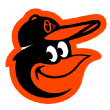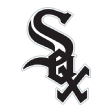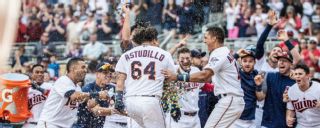|
The end of the baseball season began March 31, when the Miami Marlins' record dropped to 1-2 and their playoff odds at FanGraphs dropped to 0 percent. Not zero rounded down from 0.4, but 0.0. One by one, other teams have followed: The White Sox on April 10, the Reds and Tigers on April 15 ... until the most recent "eliminations," the Giants and Pirates on Sept. 3, the 14th and 15th teams to hit zeroes. None of these teams was technically eliminated on that date, but about as many teams come back from 0.0 as you'd expect. Indeed, of the first 15 teams to hit 0.0 this year, none has clawed back to even 1 percent at any point in the subsequent months or weeks. The first 15 have collectively played about 1,200 games, more than a quarter of a major league season, under the threat of nothing. But they play those games out of something more than obligation; they play them because there remains some potential to add to the pool of happiness in the sport. So for each dead team, we picked a day -- or a play, or a moment -- this season when the neurons fired and the brain was faintly alive. In reverse order of elimination:  Sept. 3: San Francisco Giants Sept. 3: San Francisco Giants
Record since: 4-10
Post-zero high point: Chris Stratton's Sept. 14 shutout
It helps if you were listening to the Giants game on Aug. 3, when Stratton -- having lost his spot in the rotation, then having been demoted to Triple-A -- got a spot start against Arizona. It was brutal: three innings, 14 baserunners and six runs before he left with the bases loaded and nobody out in the fourth. Stratton went right back to Triple-A, his ERA at 5.52. He looked like the fringe major leaguer we feared he was. But after he was recalled in late August, the former first-round pick made four strong starts with a 2.84 ERA, walking only three batters. Then came Sept. 14, when he threw a two-hit, complete-game shutout, snapping the Giants' record 11-game losing streak. It was, by Game Score, the 14th-best start in the major leagues this year. After that start, Stratton had lowered his ERA by almost a full run, had bumped his record up over .500 and -- because he's tied for the major league lead in shutouts -- might very well end this season with black ink on his player page. Not a bad year!  Also Sept. 3: Pittsburgh Pirates Also Sept. 3: Pittsburgh Pirates
Record since: 10-3
Post-zero high point: Jacob Stallings' walk-off hit Monday Let's briefly talk about Jacob Stallings, a 28-year-old catcher whom I'd never heard of (or probably had, but forgot about). Specifically, let's talk about two things in his splits page: 1. Fifty-five percent of all the major league games he has played in have come in September, a percentage that will go up with every game he plays this month. Now, that's only 12 out of 22 games, but that's the point: He spends day after day in Triple-A, and then September comes, and he gets to come up to the majors -- three years in a row of that. He exists in this weird backhanded compliment: He is acknowledged to be good enough to sit in a major league dugout and play major league games, but roughly 750 other living human beings are considered to be that good and slightly better, so Stallings is prevented from playing. Put another way: If baseball had added two expansion teams sometime in the past 20 years, Stallings would quite possibly be a regular major leaguer, a backup catcher to be sure but still a regular major leaguer. He'd be making $800,000 a year, he'd fluke into a .285 batting average one season, he'd retire with $10 million or so and he'd end up managing for 18 years after he retired. (His dad coached high-level college basketball for 35 years.) Instead, well, the math doesn't quite work out for him. This scarce resource is just slightly too scarce for Stallings to get it, except when rosters expand in September. So he plays in September, when he rakes. He has hit .424 in those 12 games. 2. His slash line in what are classified as "high-leverage" situations: .636/.583/.636. He had this walk-off hit against Kansas City on Monday, just as, two years ago, he had a walk-off hit against the Nationals. He has the sixth-highest OPS in high-leverage situations in history. The games barely count, his team playing as it is with 0.0 percent playoff odds, but still: He's the hero of September! Which is all to say, henceforth, we shall all vow to remember small-sample legend Jacob Stallings, as well as call him by his new nickname: Mr. September.  Aug. 12: Minnesota Twins Aug. 12: Minnesota Twins
Record since: 17-18
Post-zero high point: Willians Astudillo's Sept. 9 walk-off homer
The following tweet is not from that game but is a fair approximation of the feeling you get anytime you remember Astudillo exists: In a sport with Shohei Ohtani and Pat Venditte, Astudillo flies under the radar, but he's almost equally joyously, joyfully unique. He's a catcher (and a good-framing catcher) who, because he has limited power and a Bartolo-at-40-esque body, has had to fight his way up the minor league ladder. But unlike every other modern hitter, he almost never strikes out, which has led to some gaudy batting averages (.361 in the Venezuelan Summer League one year; .333 in Single-A; .348 in High-A; .342 in Triple-A). Ben Lindbergh has been on the Astudillo beat for a while and puts it thusly: Astudillo has produced some of the most strikeout-averse single seasons on record. The Baseball Prospectus database includes minor league records from MLB Advanced Media dating back to 2005 and incorporating almost 42,000 individual player-seasons of at least 100 plate appearances (counting 100-PA stints at multiple levels in the same season as discrete entities). Ranked by the lowest strikeout rates relative to the league, five of the top 11 entries and eight of the top 30 belong to Astudillo alone.
There's plenty more to love about him -- the top Google News headline for him right now is "Willians Astudillo is taking grounders at shortstop" -- but there has always been a tension about whether he's legit or a meme, whether his skills would translate as he moved up levels. The Twins have given him a pretty good look. It's only 65 plate appearances, but he's hitting .317, he's slugging .508, and he's struck out only twice. Anyway, here's him hitting the walk-off homer:  Aug. 8: Tampa Bay Rays Aug. 8: Tampa Bay Rays
Record since: 28-9
Post-zero high point: Blake Snell's Sept. 12 start
Here's how dooming 0.0 percent is: The Rays have won more than three-quarters of their games since then, and their playoff odds haven't climbed any higher than 0.9 percent. They've arguably been the best team in baseball since then, and it's a cute story instead of a pennant race story. But cute stories are good, too. The Rays have almost certainly been having more fun since hitting zero than they did in the months before they hit zero. Snell's start on Sept. 12 gets the nod here, out of many, many Tampa Bay/Snell victories, because it might be the start that wins him the Cy Young. He entered the game 18-5 with a 2.06 ERA but was getting squeezed on both sides of the race: Justin Verlander and Corey Kluber had arguably been a little worse, but in many more innings; Chris Sale and Trevor Bauer had thrown fewer innings but had arguably been better. But Snell's start on Sept. 12 could end up making the difference: He lowered his ERA to 2.03 (now 1.97) -- which could win the crown if Sale doesn't reach 162 innings, or does -- and took the AL lead in wins, with 19 (now 20). He did that while everybody was watching, and he did it in all caps, taking a no-hitter into the seventh inning against Cleveland, which has one of the AL's best offenses.  Aug. 6: Los Angeles Angels Aug. 6: Los Angeles Angels
Record since: 19-19
Post-zero high point: Shohei Ohtani's Sept. 5 hitting
That was the day Ohtani and the Angels announced new damage to his UCL, just a couple of days after his velocity plummeted in the early innings of a nationally televised game. Ohtani's pitching had been a sensation, as his extreme velocity and swing-and-miss secondary pitches had suggested he could be one of the best pitchers in baseball, even if he's not quite yet. Then, this: one of the bleakest days in the Angels' season. That night, Ohtani was the DH. He went 4-for-4 with two home runs. It turned out that the great potential of a two-way star wasn't whatever unrealistic scenario we had been imagining -- jogging in from his position in right field to strike out the other team's slugger, or whatever -- but this much more pragmatic one: an ace pitcher felled by injury, but because he can do other things too!, still a star. Including that night, Ohtani is hitting .378/.472/.778 since his other season ended. By OPS+, he has been the fifth-best hitter in baseball this year.  July 30: Toronto Blue Jays July 30: Toronto Blue Jays
Record since: 21-26
Post-zero high point: Thomas Pannone's Aug. 22 no-hit bid
[See "April 10: White Sox" below for details.]  July 28: New York Mets July 28: New York Mets
Record since: 27-23
Post-zero high point: Noah Syndergaard's Sept. 2 start
Before we get to Syndergaard, consider what two other Mets have done since July 28, which -- fittingly -- was a day when Jacob deGrom started, pitched well, got zero runs of support and took the loss. Since July 29, then: DeGrom: nine starts, 64 innings, 87 strikeouts, 13 walks, .195/.237/.270 line against, 1.70 ERA Zack Wheeler: 10 starts, 68 innings, 70 strikeouts, 14 walks, .179/.238/.260 line against, 1.59 ERA
For deGrom, that has (barring any veers in the final two weeks) clinched the Cy Young award. For Wheeler, who has been just about as good, it has plausibly raised hopes that next year he'll be a dark-horse ace. And then, on Sept. 2, Syndergaard threw this masterpiece: nine innings, two hits, one walk, one run, 11 strikeouts, 22 swinging strikes. It was the 11th-best start of the season, by Game Score, and a reminder that the Mets -- a bleak and miserable dark comedy this year, all the way down -- might have the best top-three starters in baseball going into the 2019 season. The Mets' being good is actually not unrealistic! And at the very least, on three out of five days, a Mets fan has a pretty good chance of seeing the team's starting pitcher absolutely dominate, strike out a dozen, allow a run or two and sometimes not take the loss.  June 29: San Diego Padres June 29: San Diego Padres
Record since: 25-44
Post-zero high point: Wil Myers hitting three homers in a game his team somehow lost by 15 Franmil Reyes homering twice on Sept. 3
Reyes -- who hit the seventh-longest home run of the season -- is 23 years old, 6-foot-5 and 275 pounds. He will someday be 32 years old, 6-foot-5 and 325 pounds, and that'll be fun in its own way, but for now, he's huge and extremely strong and also young enough that he can still run about as well as the median right fielder. On Sept. 3, he homered twice, the high point of a monthlong swell that has lifted his season from a .222/.263/.444 slash line to a .284/.340/.529 one. That is pretty good for a 23-year-old, even one who can't play defense and goes through long slumps. His floor has been bumped up to "cult favorite."  June 10: Texas Rangers June 10: Texas Rangers
Record since: 37-47
Post-zero high point: Mike Minor's June 27 no-hit bid
[See "April 10: White Sox" below for details.]  April 29: Baltimore Orioles April 29: Baltimore Orioles
Record since: 36-88
Post-zero high point: Adam Jones rejecting a trade to the Phillies
Oh, I know. You, the savvy modern baseball fan, thinks "Oh, but if he hadn't rejected that trade, we'd have gotten a live arm for the farm system, and in 2026, when the Orioles might be good again, that live arm will be in only his first year of arbitration." Adam Jones made the Orioles' future slightly worse. Slightly. But I think he single-handedly gave meaning to this Orioles season. Slightly. It would be easy to see the Orioles' season, otherwise, as entirely lost. The Orioles have the 10th-worst win percentage in the live ball era and the third-worst since the majors expanded in 1961. "Every single locker in here should be thinking, 'You know, I should be fired because I sucked. Period,'" catcher Caleb Joseph told the Athletic this week. While there are rebuilding advantages to being bad, the Orioles didn't go into this season trying to be bad. They signed players in the offseason. They had the same core that went to the playoffs two years ago. They were trying, and they all just collectively and individually sucked enough to be fired -- period. And then here's Adam Jones, a guy who has taken the Orioles to the playoffs in seasons when they were supposed to be terrible, who lives in Baltimore and gives back to Baltimore, deciding he'd rather be on a terrible team in Baltimore than a better team somewhere else. He decided there was more to the quality of the situation than a record. Sure, part of it is probably convenience, and there's a pretty good chance he'll end up signing somewhere else this winter, but when he had the choice in the middle of a bleak summer, Adam Jones said a situation has value apart from and aside from that one measure of success. He likes it there. He likes being an Oriole. And you, Orioles fan, you don't have to be ashamed, because some years are worse than others. That's just how it is. Adam Jones knows. He's been through it all. And then that night he went out and knocked three hits, and the Orioles won. (They're 12-33 since.)  April 26: Kansas City Royals April 26: Kansas City Royals
Record since: 47-82
Post-zero high point: Jorge Lopez carrying a perfect game into the ninth
[See "April 10: White Sox" below for details.]  April 15: Cincinnati Reds April 15: Cincinnati Reds
Record since: 63-75
Post-zero high point: That catch Billy Hamilton made
The Reds fired their manager three weeks into the season and fell to 8-27 before they figured the year out. The problem with a hole like that is there's really no hope of getting back to even. The hole is too deep. You can focus on getting slightly higher in the hole but not getting out. There are very few miracles in a hole. That makes each win feel small and pointless. The Reds have played almost .500 since then, and it has gotten them nowhere. A theme of almost all these teams' post-zero highlights is finding an act that doesn't feel small or pointless and can serve as a more impactful Yessssssss! moment. A hot streak, or a single game, or even a single play -- something to remind us all that these guys might be bad, but they're also, compared to the rest of the world's bodies, really, really good. Billy Hamilton is flawed. Considering his prospect hype, he's disappointing. But he's also capable of things nobody else is, and I could name at least 200 better major leaguers whom I'll forget before I forget him:  Also April 15: Detroit Tigers Also April 15: Detroit Tigers
Record since: 57-82
Post-zero high point: Back-to-back walk-off victories against the (contending!) St. Louis Cardinals this month
I have a theory that a lot of ballplayers -- most? I don't know -- care primarily about getting another at-bat. Pitchers want to pitch and get the win; batters want to bat and have runners on base when they do. They have reason to root for one another, then, because your teammates getting hits makes it more likely that you'll get to bat again, but the win or loss or the happiness one feels for a teammate is kind of secondary to (in their heart of hearts) the chance to be the hero. That's a sort of disappointing thing to believe because it makes the whole "team" conceit kind of empty, but maybe I'm wrong. I hope I'm wrong. So the Tigers, way out of everything, beat the Cardinals on a walk-off homer Sept. 7. Then, on Sept. 8, with the bases loaded, one out and the game tied in the bottom of the ninth, there was a wild pitch. This is the scene of that wild pitch:  There's a lot of happiness in that scene. The runner on second, running needlessly to third, has his arms raised in happiness. The third-base coach has his arms raised in happiness. The batter in the hole has leaped out of the dugout with his arms raised in happiness. The batter himself has his arms raised in happiness. The wild pitch cost each of those people the possibility of winning the game by doing something heroic, yet they are all happy because their team won a game on Sept. 8, while 22 games out of first place.  April 10: Chicago White Sox April 10: Chicago White Sox
Record since: 56-85
Post-zero high point: Michael Kopech's major league debut
You can get more narrative into a starting pitcher's line than any other part of a box score. Each of the Rangers, Royals, Blue Jays and White Sox has had a starting pitcher accomplish something extremely satisfying for the team in an otherwise lost season: Kopech, acquired with Yoan Moncada in the Chris Sale trade, struck out four batters in two scoreless innings before a rain delay ended his night. The White Sox's rebuild has netted a number of extremely high-profile prospects the past few years: Moncada had previously been ranked the No. 1 prospect in baseball; Lucas Giolito had been previously ranked the No. 1 pitching prospect; draftee Carlos Rodon had been rated the top talent in the 2014 draft. Each has done some things in the majors, but none has yet become a star. Kopech, in both his debut and the full start that followed, seemed like he might be the one who would break all the way through. Two weeks later, he was found to have UCL damage, and now he'll likely miss all of next season. But for those two starts, the White Sox rebuild seemed like it might have found its ace. Mike Minor, a former starter turned reliever signed this winter to a three-year deal to be a starter again, was a total gamble. It wasn't clear that he could stay healthy as a starter (he missed all of 2015 and 2016) or that he'd be good as a starter (he had an ERA+ of 75 -- terrible -- in his final season in that role). Through May, he had a 5.76 ERA in Texas, and the Rangers looked to be on the hook for a bad signing. Then it all turned around, and on June 27, he took a perfect game through six innings, eventually allowing one baserunner in seven. Since the Rangers hit 0.0 percent, Minor has a 3.00 ERA in 15 starts, and for the season, he now has the same WAR (at Baseball-Reference) as Clayton Kershaw. Great signing! Thomas Pannone had made a few relief appearances as a Blue Jay, but on Aug. 22, he made his first big league start and took a no-hitter into the seventh against the Orioles. Pretty much all of the good news for Blue Jays fans this year came in the minors, where Vlad Guerrero Jr. and Bo Bichette are two of the top 10 prospects in baseball. Pannone isn't remotely the prospect those two are, but for a day, Blue Jays fans got to feel that pleasant, radiating vibe of a young player doing something good at the highest level. Jorge Lopez was half the return the Royals got when they traded Mike Moustakas to the Brewers. In his fifth start as a Royal, he took a perfect game into the ninth inning, the longest perfect-game bid in the majors this year. Won the trade!
 March 31: Miami Marlins March 31: Miami Marlins
Record since: 58-90
Post-zero high point: When they wore teal on June 8
Don't laugh. I struggled with this one, so I asked Ely Sussman of Fish Stripes, and he told me that: "Don't laugh." Here's his explanation: It was June 8, and the Marlins -- who had fallen 10 games out of first place by the 22nd game of the season -- were already 18 games under .500. That night's game against the Padres kicked off the Marlins' 25th anniversary weekend celebration. Brian Anderson went 3-for-5, raising his line to .304/.377/.426. Kyle Barraclough, who had just taken over as the Marlins' closer, pitched a scoreless inning and lowered his ERA to 1.32. Neither had been very famous at the start of the season, but on June 8, Anderson was probably the NL's Rookie of the Year favorite, and Barraclough looked like he'd be one of the most valuable pitchers on the trade market in July. From the Marlins' last-place roster, two impact major leaguers seemed to have emerged. The long trudge out of last place starts there. The Marlins won that night, and they wore teal. "Can't overstate how popular the old color scheme is," Sussman said. "Fans rejoiced at the sight of current players in teal and all the new throwback merchandise." At the heart of this all, remember, there is a team playing because it has fans. Even in Miami, that's what this is about and has been about for, if you can believe it, 25 years. A team might know by March 31 that it isn't going to the playoffs that year. But there are still 159 games to give the fans a reason to care.
|


